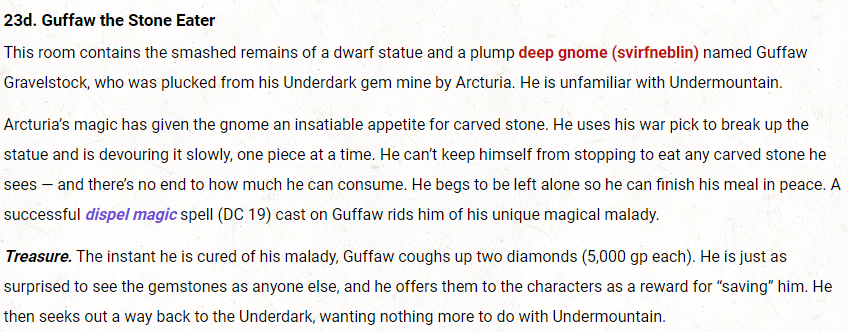Here are two encounters from Waterdeep: Dungeon of the Mad Mage. Interestingly, they appear next to each other in the book.
Which do you find easier to parse?
In my case, it’s the first one. And it’s for a simple reason: the opening paragraph tells me what to expect in the room.
For the second example, the empty classroom, my initial thought is that the players can see both a chalkboard and some desks. But wait! The desks are hidden! That isn’t immediately clear.
It’s important to be clear in a room description, as DMs tend to have trouble remembering every detail of an adventure, especially in a megadungeon like Dungeon of the Mad Mage!
Here’s another encounter from DotMM. This has an opening paragraph! Hooray! But it’s got another deceptive feature heading…
I’m fascinated about where it puts things. The characters can’t see the alcove to begin with – should it be labelled “Curtain” instead? The leather chair isn’t listed in furnishings, where you’d expect it, but in the alcove description! The alcove has something special in it, but that’s not listed there – it’s in text further down giving more details about the encounter.
I appreciate the opening paragraph. It tells me something useful about the purpose of the room.
Now consider these two rooms:
Why does one area have feature headings and the other doesn’t? Is it because there are only two features in one room? No; that’s certainly the case in other rooms! Is it because it’s a subarea? No – other subareas also use feature headers!
Good old consistency!
With these two rooms, I have no trouble parsing either encounter, although I didn’t immediately notice the heads of the creatures on the walls of area 36.
One trouble with having detailed rooms is describing the important ones to the players. Wizards have been moving away from boxed text recently, because it’s very easy for players to be distracted while its read, especially if its long. I think this also happens when a DM tries to work out what’s in a room with too many details!
Be wary of including too much visible stuff in any encounter; it’s hard for both players and DMs to keep track of it all. Using shortcuts, such as saying “it’s a library” helps significantly, as people get an immediate picture of the room, and you can make it more specific later after the initial threats of the room are dealt with.
The initial paragraph of an encounter description tends to do one of two things:
- Lets the DM know what might happen in the encounter, or
- Describes the initial set-up of the encounter.
If it doesn’t do that, then you might want to consider changing it.
Entering a room where “Ten hobgoblins commanded by a hobgoblin captain are training by shooting arrows into training dummies lined up against the east wall” gives you an immediate idea of what’s in the room, what’s occurring when the players approach, and an idea of the furnishings.
Once you move to more complicated areas, then it’s nice to mention the initial items of interest and break down into further subheadings (often of the bold italic sort) detailing the important features. So, for instance (and not a very difficult instance).
14. TRAINING AREA
Ten hobgoblins are training in this long thin room by shooting arrows into a wooden dummy. A hobgoblin captain looks on and shouts encouragement.Training Dummy. The dummy is actually an animated armor that is immune to piercing damage. If combat ensues, the captain activates it with a command word; it then attacks his enemies.
Do you need boxed text? I like it when the situation is complicated enough so that parsing it is difficult for the DM, or when you’re attempting to set the mood of an encounter.
The point of all of this? If you’re writing an adventure for publication, take some care in how you describe encounters. In particular, the first paragraph is very important, as it sets the stage for the DM. The next consideration is to arrange complex details so they can be found easily. It’s not terribly difficult, but you should read over the encounters after you’ve written them to see if they’re clear. Even better, get someone else to do it!






Nice points and comparisons. I’ve got some words about encounter formatting that say some of the same, but I think I missed a major point, and that’s what you stress: the opening paragraph.
My thoughts: https://twitter.com/timbannock/status/1105123132686266368